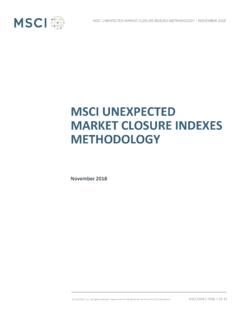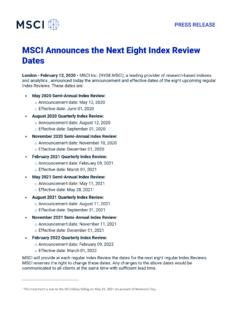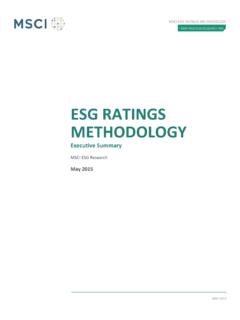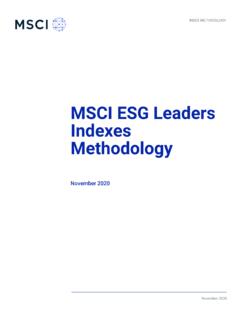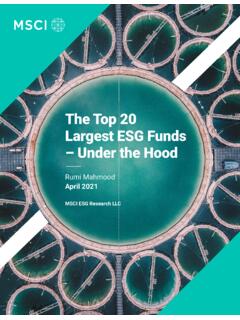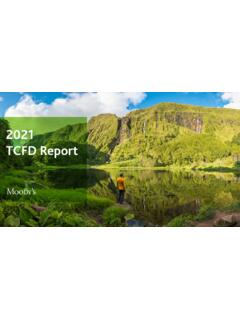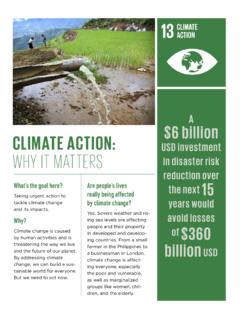Transcription of MSCI Climate Change Indexes Methodology
1 Index Methodology MSCI Climate Change Indexes Methodology May 2021. MAY 2021. MSCI Climate Change Indexes Methodology | May 2021. Contents 1 4. 2 MSCI ESG 5. MSCI Climate Change Metrics .. 5. MSCI ESG Business Involvement Screening Research .. 5. 3 Index Construction Methodology .. 6. Applicable 6. Minimum 6. Eligible Universe .. 7. Determination of Combined Score .. 8. Category Tilt Score .. 8. Relative Tilt Score .. 8. Combined Score .. 8. Weighting Scheme .. 9. Intermediate Universe .. 9. High Climate I mpact Intermediate Universe .. 9. Low Climate Impact Intermediate 9. Final 9. Capping of security weight in Final EU CTB Check ..10. 4 Maintaining the MSCI Climate Change 11. Semi-Annual Index Reviews .. 11. Ongoing Event Related Changes .. 11. Appendix I: Companies Involved in Controversial Weapons Business .. 13. Appendix II: MSCI Low Carbon Transition Risk Assessment .. 15. 2021 MSCI Inc. All rights reserved. Please refer to the disclaimer at the end of this document.
2 | PAGE 2 OF 29. MSCI Climate Change Indexes Methodology | May 2021. Appendix III: Calculation of Target Metrics .. 17. Appendix IV: Iterative Process .. 22. Appendix V: Minimum Requirements of EU CTB .. 25. 2021 MSCI Inc. All rights reserved. Please refer to the disclaimer at the end of this document. | PAGE 3 OF 29. MSCI Climate Change Indexes Methodology | May 2021. 1 Introduction The MSCI Climate Change Indexes (the Indexes ') aim to represent the performance of an investment strategy that re-weights securities based upon the opportunities and risks associated with the transition to a lower carbon economy. The Index also excludes companies meeting the below exclusion criteria . Companies involved in manfacturering of Controversial Weapons Companies involved in very severe ESG Controversies Companies involved in severe Environmental Controversies Companies involved in the Tobacco-related businesses Companies involved in Thermal Coal extraction and mining The Methodology uses the MSCI Low Carbon Transition1 (LCT) score and category to reweight constituents of a parent index to increase its exposure to companies participating in opportunities associated with transition and decrease its exposure to companies exposed to risks associated with transition.
3 As a final step, the MSCI. Climate Change Indexes are designed to exceed the minimum standards of the EU. Climate Transition Benchmark (CTB) 2. The index applies an heuristics-based approach in order to meet the following objectives . Reduce the weighted average greenhouse gas intensity by 30% (compared to the underlying investment universe. Reduce the weighted average greenhouse gas (GHG) intensity by 7% on an annualized basis Reduce the weighted average potential emissions intensity by 30%. (compared to the underlying investment universe. Have at least equivalent ratio of weighted average Green Revenues to weighted average Brown Revenues as that of the underlying investment universe. 1. Please refer to Appendix II: MSCI Low Carbon Transition Risk Assessment and for further details regarding the MSCI Low Carbon Transition score and category 2. In case there are changes in the EU delegated acts (Regulation (EU) 2016/1011 as amended by Regulation (EU). 2019/2089) and an update to the Index Methodology is required, MSCI will issue an announcement prior to implementing the changes in the Methodology .))
4 MSCI will not conduct a formal consultation for such an update. 2021 MSCI Inc. All rights reserved. Please refer to the disclaimer at the end of this document. | PAGE 4 OF 29. MSCI Climate Change Indexes Methodology | May 2021. 2 MSCI ESG Research MSCI ESG Research provides in-depth research, ratings and analysis of the environmental, social and governance-related business practices of thousands of companies worldwide. It consists of an integrated suite of tools and products to efficiently manage research, analysis and compliance tasks across the spectrum of ESG factors. The Index uses company ratings and research provided by MSCI ESG Research. In particular, this index uses the following MSCI ESG Research products: MSCI Climate Change Metrics and MSCI ESG Business Involvement Screening Research. For details on MSCI ESG Research's full suite of ESG products, please refer to: MSCI Climate Change METRICS. MSCI Climate Change Metrics is designed to support investors seeking to achieve a range of objectives, including measuring and reporting on Climate risk exposure, implementing low carbon and fossil fuel-free strategies, and factoring Climate Change research into their risk management processes.
5 It provides Carbon Emissions, Fossil Fuel exposure, environmental impact ( , clean technology) data and screens, as well as Climate -related risk exposure and management assessment on companies. For more details on MSCI Climate Change Metrics, please refer to MSCI ESG BUSINESS INVOLVEMENT SCREENING RESEARCH. MSCI ESG Business Involvement Screening Research (BISR) aims to enable institutional investors to manage environmental, social and governance (ESG). standards and restrictions reliably and efficiently. For more details on MSCI ESG Business Involvement Screening Research, please refer to 2021 MSCI Inc. All rights reserved. Please refer to the disclaimer at the end of this document. | PAGE 5 OF 29. MSCI Climate Change Indexes Methodology | May 2021. 3 Index Construction Methodology APPLICABLE UNIVERSE. The applicable universe includes all the existing constituents of the parent index ( Parent Index ). This approach aims to provide an opportunity set with sufficient liquidity and capacity.
6 MINIMUM REQUIREMENTS. The requirements 3 MSCI imposes for the MSCI Climate Change Indexes are detailed in Table 1. Table 1: Requirements imposed for the MSCI Climate Change Indexes Requirements MSCI Climate Change Indexes Minimum reduction in Weighted Average Scope 1+2+3 Carbon 30%. Emissions Intensity (WACI) relative to Parent Index Minimum reduction in Weighted Average Potential Emissions Intensity 30%. relative to Parent Index Controversial Weapons ESG Controversy Score 4 of 0. Tobacco Involvement Baseline Exclusions Orange Flag Environmental Controversies Thermal coal mining Minimum average reduction (per annum) in WACI relative to WACI in 7%. the Base Date Minimum ratio of Green Revenue/. Brown Revenue relative to Parent At least equivalent Index 3. the minimum requirements for EU Climate Transition Benchmarks in the EU Delegated Acts are detailed in Appendix V. 4. The evaluation framework used in MSCI ESG Controversies is designed to be consistent with international norms represented by the UN Declaration of Human Rights, the ILO Declaration on Fundamental Principles and Rights at Work, and the UN Global Compact.
7 For more details on MSCI ESG Controversies, please refer to 2021 MSCI Inc. All rights reserved. Please refer to the disclaimer at the end of this document. | PAGE 6 OF 29. MSCI Climate Change Indexes Methodology | May 2021. Active weight in High Climate Impact Sector relative to Parent Index as 0%. defined in Appendix III. Aims to achieve higher allocation to Corporate Target Setting companies that set carbon reduction targets. ELIGIBLE UNIVERSE. The eligible universe is constructed by excluding securities based on the following criteria: Controversial Weapons: Companies involved in Controversial Weapons ( cluster munitions, landmines, depleted uranium weapons, biological/chemical weapons, blinding lasers, non-detectable fragments and incendiary weapons), as defined by the Methodology of the MSCI Ex- Controversial Weapons Indexes . For more details on the controversial weapons exclusion, please refer to Appendix I. Tobacco: All companies with involvement in Tobacco as defined by the Methodology of the MSCI Global ex Tobacco Involvement Indexes .
8 Environmental Harm: All companies having faced very severe and severe controversies pertaining to Environmental issues Defined as companies with an Environment Controversy Score of 0 or 1. Thermal Coal Mining: All companies deriving 1% or more revenue (either reported or estimated) from the mining of thermal coal (including lignite, bituminous, anthracite and steam coal) and its sale to external parties. It excludes revenue from metallurgical coal, coal mined for internal power generation ( in the case of vertically integrated power producers), intra- company sales of mined thermal coal, and revenue from coal trading (either reported or estimated). Missing LCT Category/Score: Companies not rated by MSCI ESG Research for Low Carbon Transition Assessment. Additionally, companies are required to have a minimum ESG Controversy Score of 1. to be eligible in the index. 2021 MSCI Inc. All rights reserved. Please refer to the disclaimer at the end of this document.
9 | PAGE 7 OF 29. MSCI Climate Change Indexes Methodology | May 2021. DETERMINATION OF COMBINED SCORE. Each company in the eligible universe is assigned a Combined Score, which is calculated using a company's LCT Category and its Low Carbon Transition Score as outlined below. CATEGORY TILT SCORE. The Category Tilt Score' is used to express relative tilt towards or away from a stock based on the LCT Category. Based on the LCT Category of a company, a Category Tilt Score is assigned based on the table below: LCT Category Category Tilt Score Solutions 3. Neutral 1. Operational Transition Product Transition Asset Stranding RELATIVE TILT SCORE. The Relative Tilt Score' differentiates companies within an LCT Category. Companies with higher LCT Score are determined by MSCI ESG Research to be relatively better at managing their Climate related risk compared to their peers with worse LCT Score. The Relative Tilt Score is calculated by normalizing security level LCT score relative to the maximum5 LCT Score of the LCT Category within the Parent Index.
10 The Relative Tilt Score' is floored at to balance its effect on the final weight of index constituents . =. 2 . COMBINED SCORE. The Combined Score is calculated for each company as follows: Combined Score = Category Tilt Score * Relative Tilt Score. 5. To account for potential outliers within each LCT Category, the category maximum LCT Score is calculated after winsorizing the security level LCT Score at 90 th percentile of the LCT Category. 2021 MSCI Inc. All rights reserved. Please refer to the disclaimer at the end of this document. | PAGE 8 OF 29. MSCI Climate Change Indexes Methodology | May 2021. WEIGHTING SCHEME. At each rebalancing, all the securities from the eligible universe are weighted by the product of their weight in the Parent Index and the Combined Score. = . The above weights are then normalized to 100%. INTERMEDIATE UNIVERSE. Each security in the Applicable Universe is classified into one of two Climate impact sectors 6 based on its NACE section code.



